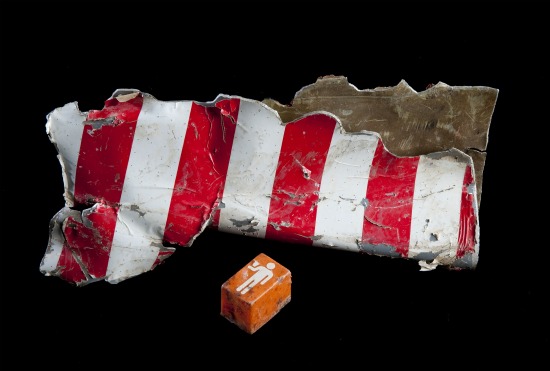Remembering 9/11 at the American History Museum
Visitors from across the country have made a pilgrimage to the Smithsonian to see an exhibit about the fateful day 10 years ago
![]()
Most of those waiting in the long line to enter “September 11: Remembrance and Reflection” behave like normal tourists on vacation in a museum. They jostle each other, joke around and pose for snapshots to pass the time. Elsewhere in the American History Museum, families with overtired children cruise past some of the drier displays, while teenagers chatter on cell phones and ask about lunch.
But inside the exhibition, when I visited this week, the atmosphere was something entirely different. Visitors lingered around the tables of artifacts, asking questions of the museum staff on hand and telling their own stories, unprompted. They explained to their younger children why tattered dolls and shards of metal airplane casing were laid out neatly on display tables. Watching the film shown at the end of the exhibit, they sat spellbound, with necks craned forward, gazing silently at the clips they’d seen repeated incessantly ten years earlier. When those on screen reflected on the atmosphere they felt on the day of the attacks, some audience members couldn’t help but unconsciously nod along.
Many of the visitors’ arrivals from cities and small towns across the country to see the exhibition reminded me of a pilgrimage. And as midday rain poured down on the deserted National Mall outside, the exhibit goers packed into the small room began to seem, unexpectedly, something like a community.
At the exhibition–on display for just ten days, marking the tenth anniversary of September 11, 2001–visitors deliberately made their way among tables with artifacts sorted by location, laid bare without cases or extensive commentary notes. From New York, they looked at missing person posters, a battered briefcase from one of the towers and a squeegee handle used to break through drywall in a desperate escape. Mayor Rudy Guiliani’s clunky cell phone showed just how much time has passed in technological years since the attacks.
At the table of objects from here in D.C., exhibit-goers read a postcard sent by a passenger right before she boarded Flight 77, telling her family excitedly about a trip to Australia, and saw a clock from the Pentagon, frozen at the time of impact. From Flight 93, downed in Shanksville, Pennsylvania, were countless objects of everyday airplane tedium–a call button, a flight safety booklet and a window shade–touched with unmistakable gravity.
Ten years: not quite close enough to feel like raw suffering, but too recent to be entombed in a history textbook. For me–I was in middle school at the time–the event itself is often overshadowed by all of the consequences of it that have happened since.
But being at the exhibition, among a group of people who clearly had personal ties severed by the attacks, had a way of re-establishing just how big it really was. As we watched “9/11: Stories in Fragments”, the Smithsonian Channel documentary screened at the end of the exhibition, the archival news clips shown took on the same air of critical urgency they had on the day ten years earlier. After the film ended with a final news report from that night, everyone remained still in their chairs, transfixed, as though expecting the movie to continue in time, documenting the past decade of life as it had for the day of the attacks.
At the exit of the exhibition is a bulletin board where visitors are invited to provide their own response to a prompt: “How did you witness history on September 11, 2001? Tell us your story.” I saw people earnestly recording their thoughts at the writing tables; I saw political statements, meticulous records, love letters and children’s drawings pinned up. Just before leaving, a woman walked up and hung up her brief note. “I think carefully before going on trips, planning for the chance of tragic circumstances,” it read. “I definitely tell family and friends that I love them.”
The exhibit is on view through Sept. 11.
/https://tf-cmsv2-smithsonianmag-media.s3.amazonaws.com/accounts/headshot/joseph-stromberg-240.jpg)

/https://tf-cmsv2-smithsonianmag-media.s3.amazonaws.com/accounts/headshot/joseph-stromberg-240.jpg)